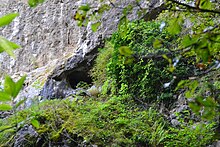Philippe-Charles Schmerling


Center below: upper jaw of the Neanderthal child Engis 2 , next to it fossils of Homo sapiens
Philippe-Charles Schmerling (born March 2, 1790 (?) In Delft , † November 17, 1836 in Liège ) was a Belgian doctor , anatomist and paleontologist . He is considered to be one of the pioneers of paleoanthropology and paleopathology . Schmerling the first scientific description dates back to a Neanderthal belonging Fossils .
life and work
Schmerling first studied anatomy in Delft and later medicine in Liège, where he received his doctorate in medicine in 1825. In 1829 he stayed near Flémalle , where he came into contact with fossil sites.
26 years before Darwin's epochal work On the Origin of Species , Schmerling was the first to describe bone finds - which he himself discovered in Belgium in the caves of Engis and Engihoul in 1829 - as fossil on the one hand and as old as the extinct remains on the other Mammals from the same localities; Based on the animal fossils and stone tools that were also discovered , he assigned his finds to the "Diluvium" (the era of the Flood ). However , this interpretation was not taken up by the naturalists of the time . At first nothing changed in this regard after those fossils from the Feldhof Grotto were available in 1857 ( Neandertal 1 ), which have been called Neanderthals since 1864 .
Even Charles Lyell , who had also explored the two Belgian caves and agreed to Schmerling's interpretations in 1863, fell on largely deaf ears from his contemporaries. Instead, the opinion of Thomas Henry Huxley prevailed, who described the anatomical features of the finds from Belgium and from the Feldhofer Grotto in detail, but came to the conclusion that, among other things, due to the unusual appearance of the skull bones compared to modern humans they were modern people with a low level of civilization. He substantiated this interpretation by pointing out that it was possible to use the skulls of his contemporaries from different regions of the world to demonstrate a seamless transition from primitive to advanced features.
Only with the recognition of the theory of descent was the fact recognized by Schmerling widely shared that there are both extinct animal and plant species and extinct species of the genus Homo .
The fossil Engis 1 discovered by Schmerling (an almost completely preserved skull) is now interpreted as an anatomically modern human ( Homo sapiens ). Engis 2 is a partially preserved Neanderthal child's skull with a separately found upper jaw and is considered the first scientifically described fossil of the Neanderthal. The whereabouts of the bone fragments designated as Engis 3 is unknown, as is their ancestral origin.
Because of his comments on pathological findings in the animal fossils he discovered, Schmerling is also considered one of the pioneers of paleopathology .
Honors
In 1834 he was elected a member of the German Academy of Sciences Leopoldina .
Individual evidence
- ↑ According to other sources, Schmerling was born on February 24, 1791. According to Liliane Henderickx (in: Philippe Charles Schmerling (1790–1836) révèle l'antiquité de l'homme grâce aux dépôts antédiluviens des grottes liégeoises. In: Revue d'Archéologie et de Paléontologie , Volume 10, 1991, pp. 24-66 ) the dating to the year 1791 is based on an error by Charles François Antoine Morren in his writing: Notice sur la vie et les travaux de Philippe-Charles Schmerling. In: Annuaire de l'Académie royale de Belgique , Volume 4, 1838, ( Google Books) , which also mentioned the year 1790 elsewhere.
- ^ Philippe-Charles Schmerling: Recherches sur les ossements fossiles découverts dans les cavernes de la Province de Liège. PJ Collardin, Liège 1833–1834 (2 volumes)
- ^ Charles Lyell : The geological evidences of the antiquity of man. George W. Childs, Philadelphia 1863
- ^ Thomas Henry Huxley : Evidence as to Man's Place in Nature. D. Appleton and Company, New York 1863, Chapter 3; German: Testimonies for the position of man in nature. Translated by Julius Victor Carus. Friedrich Vieweg and son, Braunschweig 1863
- ↑ in the original edition, pp. 179–180, 183
- ↑ Member entry of Philipp Charles Schmerling at the German Academy of Natural Scientists Leopoldina , accessed on November 14, 2015.
| personal data | |
|---|---|
| SURNAME | Schmerling, Philippe-Charles |
| BRIEF DESCRIPTION | Belgian doctor in paleontologist |
| DATE OF BIRTH | March 2, 1790 |
| PLACE OF BIRTH | Delft |
| DATE OF DEATH | November 17, 1836 |
| Place of death | Liège |
